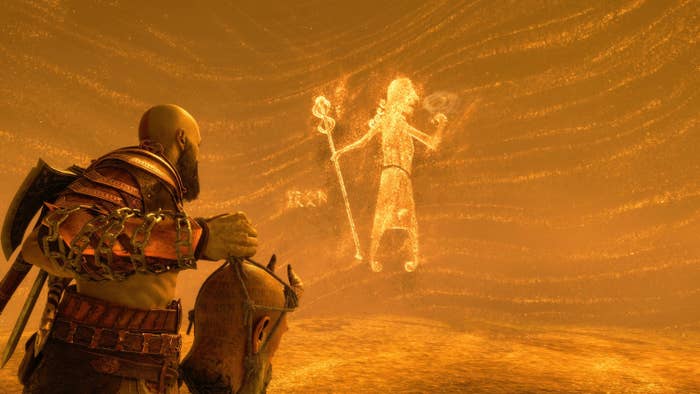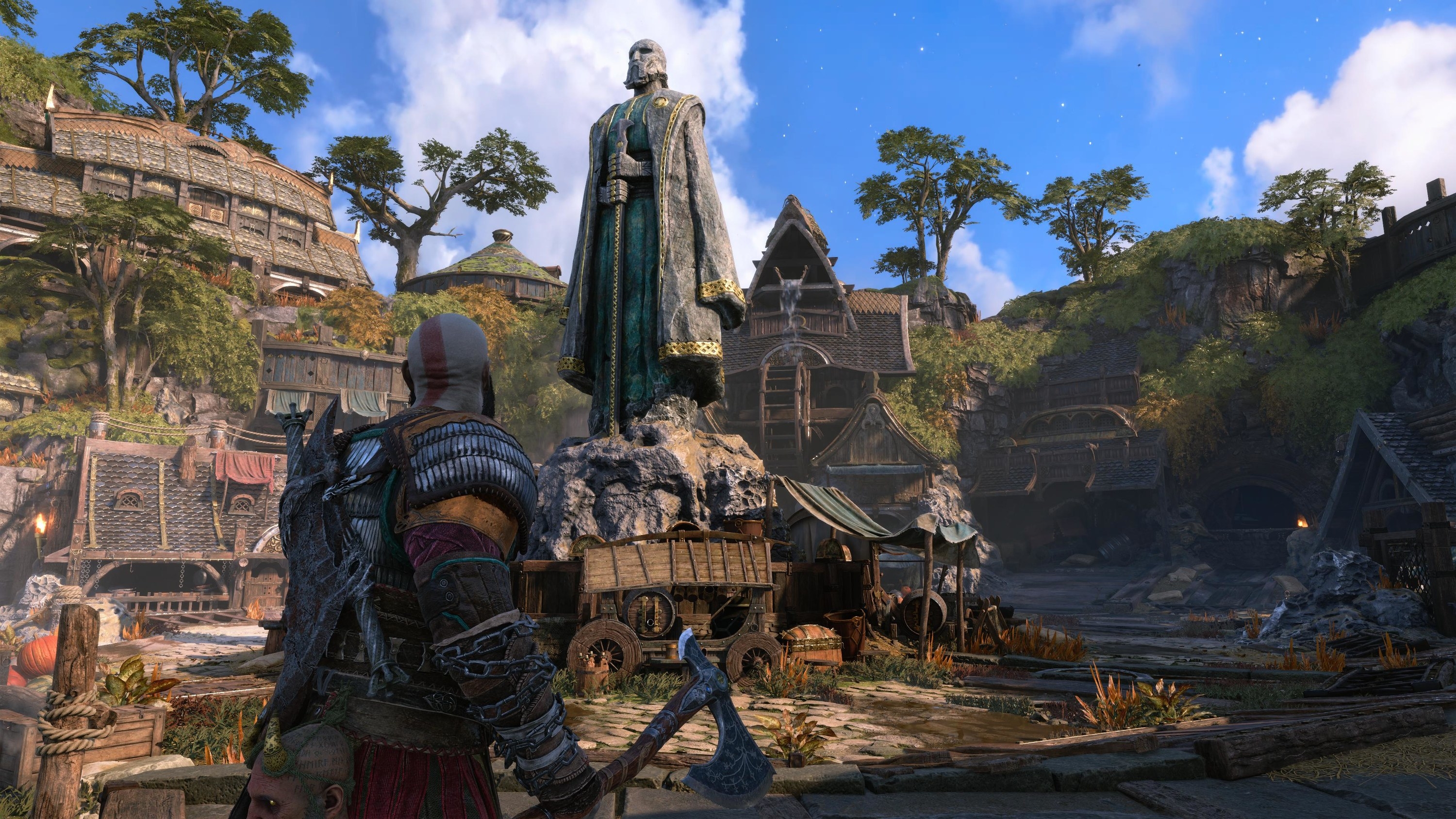
BuzzFeed may collect a share of sales or other compensation from the links on this page if you decide to shop from them. Prices are accurate and items in stock as of the time of publication.
If you haven't played 2018's PlayStation 4 game God of War, go do that. We’ll wait… So, did you hate it? Then don't worry about this review. But if you loved its deep combat system and its thoughtful depiction of a tenuous relationship between father and son, then boy, do I have some fantastic news about its sequel. God of War Ragnarök is what happens when a development team (Santa Monica Studio) looks at a hugely successful title and says, "What if we just made everything, you know, better?" — and actually pulls it off.
I spent more than 40 hours playing through Ragnarök, out now on PS4 and PS5, and here's what you should know, spoiler-free.
The Plot
In 2018's GoW, we saw a protagonist much mellowed from the seven earlier hack-and-slash GoW titles. A god-slayer named Kratos, himself a god, just wanted to settle down with a family! Have a kid! Live a quiet life in the woods in a world inspired by Norse mythology! But his wife died, leaving him with a son he couldn't connect to and a quest to spread his spouse’s ashes from the highest peak in all the realms. That kicked off a reflective journey for both Kratos and his son, Atreus, that saw the old warrior struggling to learn how to let his child be close to him — while killing a god or two in the process.
In Ragnarök, we rejoin Kratos and Atreus three years later, training hard and surviving a harsh winter prophesied to precede, well, Ragnarök, or the end of the world. In an effort to stop doomsday, the pair travel — sometimes together, sometimes apart — to all nine realms (more than in the first game, where only a handful were accessible). The journey brings the pair together with friends old (like the talking head of Mímir) and new (the giant Angrboda). There are also a few complete assholes they have to deal with, including Odin, Thor, and the realm of Asgard's three-time Most Punchable Face champion, Heimdall.

Things get more difficult as Kratos (voiced by Christopher Judge at his rumbliest) struggles with trusting his son. Atreus (deftly portrayed by Sunny Suljic) is keeping his own secrets as he works to figure out who he is while trying to prevent Ragnarök in his own way. Fortunately, things never veer too far into surly teendom.
Kratos spent the last GoW learning how to be close to his son. Now, with Atreus aching to go off on his own, he must learn how to be apart.
The Feel
After the frenetic pace of the first seven God of War games, the 2018 release slowed things down and let plot and character development play out over quiet moments spent paddling in a canoe across serene waters. It was slow to get going, frustrating some players. Ragnarök is much the same. Which is not to say that it's boring.
Ragnarök allows ancillary characters from the 2018 game to fill out their backstories and shine. Anyone who loved the universe of GoW will be thrilled with how Ragnarök fleshes it out, both in the main story and, more importantly, in side quests. In many games, side quests are dumping ground for plot filler. They're aggressively fine. But in Ragnarök, they're a must-do: You will miss entire character arcs if you just shrug your shoulders and stick to the main storyline.

Along the way, Kratos and Atreus spend a lot of time with other characters, having deep conversations that amplify the game's overarching theme that it's not what you've done, but what you do next. The dwarf Sindri opens up to Atreus about a secret he's keeping from Brok, his brother. A vulnerable Kratos opens up to a grieving Freya (Danielle Bisutti). Mímir (Alastair Duncan) reveals burdens that have chained him down for centuries.
Each of the nine realms has a distinct style and feel — the icy reaches of Midgard, the verdant Vanaheim, the sulfurous Svartalfheim — and is richly rendered. You'll spend more time in some, less in others, but they all reward patience and exploration. And there’s a lot to explore here: It took me 45 hours to complete the main story and side quests, and I still have more to investigate.
The Gameplay
The hack-and-slash gameplay for the series remains tight, with extensive skill trees for each of Kratos's three weapons. (Yes, three, up from the last games' two. I won't spoil the third one other than to say that it feels just right, has its own unique mechanics, and the quest to get it is contemplative and revealing.) The controls are responsive and smooth, so the times I died — and there were many — were all my fault.

There are five difficulty settings, so whether you're, say, an impatient journalist on a deadline or someone who revels in dying over and over until you manage to defeat a boss, you can find a comfortable level. You can remap the buttons on the entire controller, which is great if you're just coming off sinking 140 hours into Elden Ring and you're still trying to mash O to dodge (here, it's X).
The Bad
The game is not without its flaws. The most glaring is how empty the world you're supposed to be saving feels. The dwarven city of Svartalfheim, for instance, barely has any dwarves. I presume some of this is to lighten the graphical load for the PS4 version. That console has sold tens of millions more than the PS5 to date but came out almost nine years ago and is far behind graphics-wise.

I experienced several crashes, once while pulling up the in-game menu to read a bit of lore I'd just discovered, and another time in the middle of the end credits. I was able to get back into the game easily enough, and Ragnarök's robust autosave system meant I didn't lose any progress, but it was jarring nonetheless. (The menu bug has since been patched, at least.)
The menu can also be overwhelming. Having so many things to tweak — armor, abilities, and skills — is great from a variety perspective, but less so in terms of ease of navigation. There are so many things you can level up that I was still finding new ones deep into the game's second act (but you may be more observant than I).
The Endgame
When Ragnarök's credits appear, you're not done. There are still riddles to be solved and bosses to slay. And anyone who puts the controller down for good will miss one of the most meaningful scenes in the entire game.

Ragnarök is stuffed full of small, meaningful moments I'd love to have shared in this review, but won't. To reveal them wouldn't break the review agreement but would do something worse: ruin your chance at embarking on a thought-provoking journey that was clearly a labor of love on the part of the developers.
By the end, I must admit, I was a bit sniffly. My wife, who was watching alongside me, had to grab some tissues for herself. Sure, it’s got dismemberment and beheadings, and the save-the-world stakes couldn’t be any higher, but Ragnarök is ultimately an intimate, tender game about loving your child — and knowing when to trust and let go.
God of War Ragnarök is out now for the PlayStation 4 at $59.99 and PlayStation 5 at $69.99. Sony provided a copy to BuzzFeed News for review purposes.
